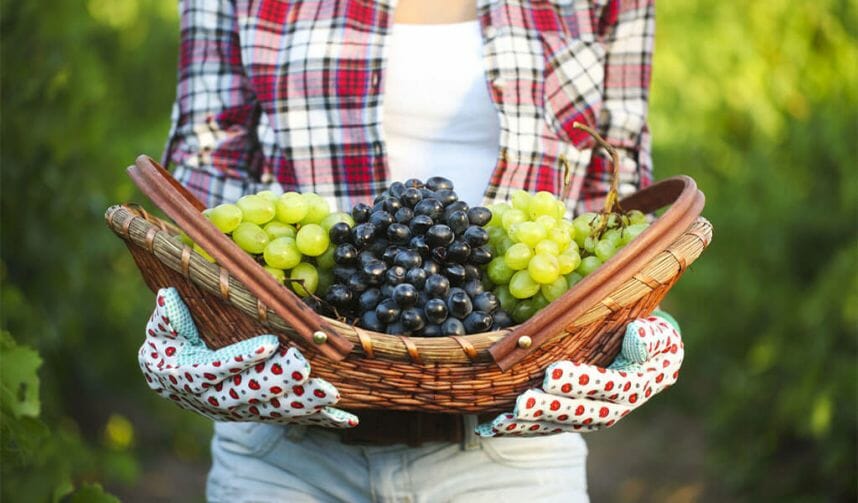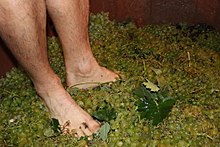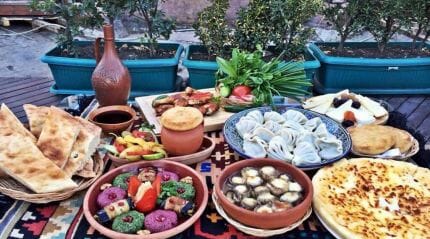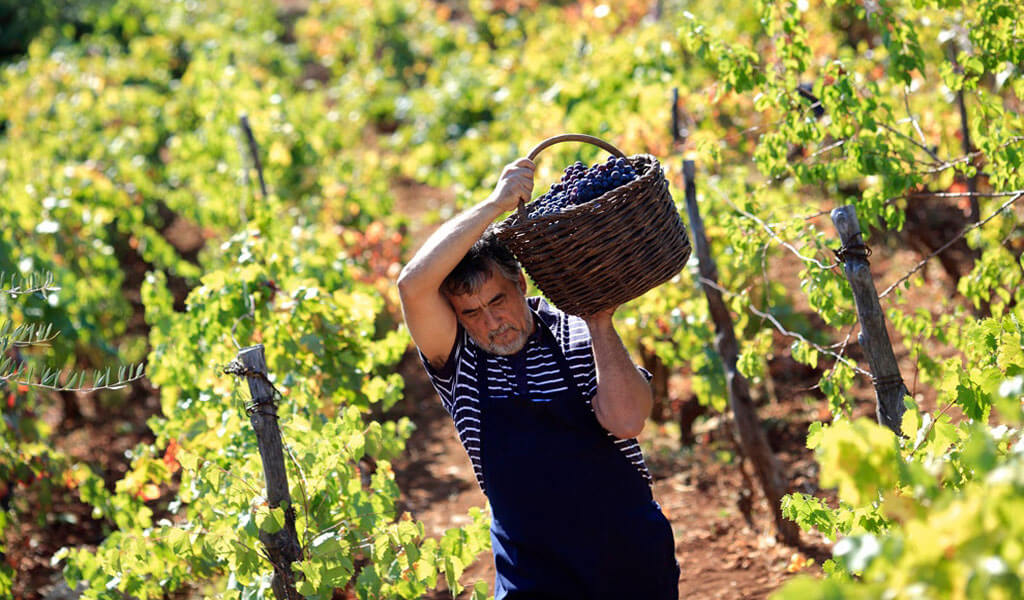From Wikipedia, the free encyclopedia
(Redirected from Stomp grapes)
Grape stomping during the a traditional grape harvest festival in Spain.
Grape-treading or grape-stomping is part of the method of maceration used in traditional wine-making.[1][2][3] Rather than being crushed in a wine press or by another mechanized method, grapes are repeatedly trampled in vats by barefoot participants to release their juices and begin fermentation. Grape-treading was widespread in the history of winemaking, but with the introduction of industrial methods, it now survives mostly as a recreational or competitive activity at cultural festivals.
History[edit]
One of the earliest extant visual representations of the practice appears on a Roman Empire sarcophagus from the 3rd century AD, which depicts an idealized pastoral scene with a group of Erotes harvesting and stomping grapes at Vindemia, a rural festival.[4]
Many contemporary wineries hold grape-stomping contests to attract visitors. The practice is also the subject of many depictions in contemporary media, including the 1974 Mel Tillis song «Stomp Them Grapes», the I Love Lucy episode «Lucy’s Italian Movie», and The Littlest Grape Stomper,[5] a children’s book by Alan Madison.[6]
The novel The Secret of Santa Vittoria and the film based on it, taking place in a wine-producing Italian town during WWII, include a grape treading scene which has a major role in the battle of wits between the townspeople and their German occupiers.
Special Experience[edit]
Harvest experience tours, also known as «harvest internships» or «crush camps,» are tours or programs that allow visitors to experience the winemaking process firsthand by participating in the grape harvesting and crushing process. These tours are usually offered during the grape harvesting season, which varies depending on the region and the type of grapes being harvested. Harvest experience tours can be a fun and educational way to learn about the winemaking process and to see behind the scenes at a working winery.
See also[edit]
- Posting (laundering process), a method of treading laundry with the feet.
- Winepress
References[edit]
- ^ Naked Wine: Letting Grapes Do What Comes Naturally. Da Capo Press, ISBN 9780306820489
- ^ Clarke, Oz (2009). Oz Clarke’s Pocket Wine Guide 2010. Sterling Publishing Company, ISBN 9781402771248
- ^ Cheap, BA (2010). Mr. Cheap’s Guide to Wine. Adams Media, ISBN 9781440517594
- ^ Wight, Karol (2008). Roman sarcophagus, c. 290-300 AD. The J. Paul Getty Museum
- ^ Madison, Alan (27 February 2007). The Littlest Grape Stomper. Schwartz & Wade. ISBN 978-0375836756.
- ^ Hope, Morrison (2007). The Littlest Grape Stomper (review). Bulletin of the Center for Children’s Books, Volume 60, Number 9, May 2007
External links[edit]
Media related to Grape treading at Wikimedia Commons
- World Championship Grape Stomp via Sonoma County Harvest Fair
From Wikipedia, the free encyclopedia
(Redirected from Stomp grapes)
Grape stomping during the a traditional grape harvest festival in Spain.
Grape-treading or grape-stomping is part of the method of maceration used in traditional wine-making.[1][2][3] Rather than being crushed in a wine press or by another mechanized method, grapes are repeatedly trampled in vats by barefoot participants to release their juices and begin fermentation. Grape-treading was widespread in the history of winemaking, but with the introduction of industrial methods, it now survives mostly as a recreational or competitive activity at cultural festivals.
History[edit]
One of the earliest extant visual representations of the practice appears on a Roman Empire sarcophagus from the 3rd century AD, which depicts an idealized pastoral scene with a group of Erotes harvesting and stomping grapes at Vindemia, a rural festival.[4]
Many contemporary wineries hold grape-stomping contests to attract visitors. The practice is also the subject of many depictions in contemporary media, including the 1974 Mel Tillis song «Stomp Them Grapes», the I Love Lucy episode «Lucy’s Italian Movie», and The Littlest Grape Stomper,[5] a children’s book by Alan Madison.[6]
The novel The Secret of Santa Vittoria and the film based on it, taking place in a wine-producing Italian town during WWII, include a grape treading scene which has a major role in the battle of wits between the townspeople and their German occupiers.
Special Experience[edit]
Harvest experience tours, also known as «harvest internships» or «crush camps,» are tours or programs that allow visitors to experience the winemaking process firsthand by participating in the grape harvesting and crushing process. These tours are usually offered during the grape harvesting season, which varies depending on the region and the type of grapes being harvested. Harvest experience tours can be a fun and educational way to learn about the winemaking process and to see behind the scenes at a working winery.
See also[edit]
- Posting (laundering process), a method of treading laundry with the feet.
- Winepress
References[edit]
- ^ Naked Wine: Letting Grapes Do What Comes Naturally. Da Capo Press, ISBN 9780306820489
- ^ Clarke, Oz (2009). Oz Clarke’s Pocket Wine Guide 2010. Sterling Publishing Company, ISBN 9781402771248
- ^ Cheap, BA (2010). Mr. Cheap’s Guide to Wine. Adams Media, ISBN 9781440517594
- ^ Wight, Karol (2008). Roman sarcophagus, c. 290-300 AD. The J. Paul Getty Museum
- ^ Madison, Alan (27 February 2007). The Littlest Grape Stomper. Schwartz & Wade. ISBN 978-0375836756.
- ^ Hope, Morrison (2007). The Littlest Grape Stomper (review). Bulletin of the Center for Children’s Books, Volume 60, Number 9, May 2007
External links[edit]
Media related to Grape treading at Wikimedia Commons
- World Championship Grape Stomp via Sonoma County Harvest Fair

Праздник Ртвели – истинная душа Грузии. Ртвели длится с начала сентября до начала октября.
Это время, когда все члены многочисленных семейств, включая внучатых племянников и еще более дальних родственников, съезжаются со всех концов страны к родовым виноградникам на сбор урожая. Рады в это время и гостям, которым тут же выдадут годори – особую продолговатую корзину, в которую складывают собранные гроздья.
Давят виноград старинным дедовским способом, ногами в сацнехели, деревянном корыте, в котором есть отверстие, из которого сок поступает в специальный сосуд.
Грузинское застолье
Но главное в празднике – это конечно длинные застолья с вкуснейшими шашлыками, хачапури, и прошлогодним вином, которое льется рекой. Оно и понятно, ведь надо срочно освобождать сосуды для нового вина.
Время праздника в каждом регионе разное, оно зависит от срока созревания винограда. Так в 2015 году Ртвели в Кахетии (Восточная Грузия) стартовал в начале сентября, а в регионе Рача (Западная Грузия) — в первой декаде октября.
Собираетесь в Грузию? Напишите на info@v-georgia.com – мы составим для вас оптимальный маршрут путешествия. Приезжайте, а мы постараемся сделать ваш отдых незабываемым! Получить бесплатную консультацию можно по телефону +995 555 566 540 *WhatsApp *Viber
сбор винограда на Ртвели
Государство субсидирует сбор винограда, выплачивая виноградарям небольшую компенсацию за каждый собранный килограмм. В этом году госсубсидия составит порядка $10,7 млн.
Источник: www.forbes.ru
Здравствуйте. Раньше я жила в Грузии. Там после сбора винограда устраивался целый праздник. Виноградный урожай помещался в огромный чан и его давили ногами. Зачем это делать, ведь есть же, наверное, другие, более цивилизованные способы? Честно говоря, после такого зрелища я, как очень брезгливый человек, не стала пить вино. А вдруг…
Тамара Романова, Ростовская обл., г. Волгодонск
Уважаемая Тамара. В заводских условиях виноград давят специальными прессами. Так что «вкуса» чьих-то ног можете не бояться. Многие виноградари считают, что если виноград давить какими-нибудь механическими приспособлениями, то есть риск раздавить косточки внутри виноградин. это приведет к горечи вина, приготовленного из полученного виноградного сока, поэтому его предпочитают давить руками. В древности виноград давили юные девушки, ноги которых были мягкими и нежными. Тогда при давлении винограда совершался целый ритуал, а точнее — ритульный танец. Вот и танцевали его на винограде. Теперь такой способ служит скорее данью традиции.




